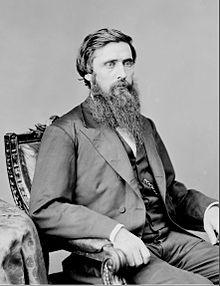John Rawlins | |
|---|---|
 | |
| 29th United States Secretary of War | |
| In office March 13, 1869 – September 6, 1869 | |
| President | Ulysses S. Grant |
| Preceded by | John Schofield |
| Succeeded by | William Tecumseh Sherman (acting) |
| Personal details | |
| Born | John Aaron Rawlins February 13, 1831 Galena, Illinois, U.S. |
| Died | September 6, 1869 (aged 38) Washington, D.C., U.S. |
| Resting place | Arlington National Cemetery |
| Political party | Democratic (Before 1868) Republican (1868–1869) |
| Spouse(s) | Emily Smith (1855–1861, her death) Emma Hurlburt (1863–1869, his death) |
| Children | 6 |
| Signature | |
| Military service | |
| Allegiance | |
| Branch/service | • Union Army |
| Years of service | 1861–1869 |
| Rank | |
| Battles/wars | American Civil War |
John Aaron Rawlins (February 13, 1831 – September 6, 1869) was a general officer in the Union Army during the American Civil War and a cabinet officer in the Grant administration. A longtime confidant of Ulysses S. Grant, Rawlins served on Grant's staff throughout the war, rising to the rank of brevet major general, and was Grant's chief defender against allegations of insobriety. He was appointed Secretary of War when Grant was elected President of the United States.
Rawlins was a self-made man who overcame an impoverished family background, scanty education, and an absentee father who was prone to drink. After studying law, Rawlins passed the bar in 1854 and started a practice in Galena, Illinois. He was a Douglas Democrat at the outbreak of the Civil War; a noted public speaker, he gave a notable pro-Union speech at the start of hostilities, and he soon became close friends with Ulysses S. Grant, a Galena resident, United States Military Academy graduate, and Mexican–American War veteran who had served in the Army for 11 years. Rawlins persuaded Grant to drill and muster a local volunteer militia company and send them to the state capital in Springfield so they could be inducted into federal service. After brief service in the Illinois militia as a mustering officer, Grant was soon recommissioned in the Army to serve under Union General John C. Frémont, commander of Union Army forces in the western United States. Rawlins also joined the Union Army and served primarily as an officer on Grant's staff; his promotions were linked to Grant's success on the battlefields and Grant's advancement in the Union Army under President Abraham Lincoln. Rawlins contracted tuberculosis in 1863, but continued to serve on Grant's staff during Reconstruction.
After Grant won the 1868 election and assumed the presidency in March 1869, he named Rawlins as his Secretary of War. With the exception perhaps of his approving the height of the Brooklyn Bridge, before construction, Rawlins' brief tenure saw several controversies. Rawlins supported insurrection against Spanish rule in Cuba, established an anti-Mormon policy for the Utah Territory, and reduced the authority of General William Tecumseh Sherman, Grant's successor as commander of the Army. Rawlins' tuberculosis continued to worsen, and he died in September 1869, five months into his term. Except for a 1916 biography, The Life of John A. Rawlins, by James Harrison Wilson, Rawlins' short life is not well known, while Grant, perhaps protecting his own reputation, rarely mentioned him in his popular Memoirs, published in 1885. With Rawlins' death, strong cabinet-level support for an independent Cuba ended, and did not become a priority until the Spanish–American War in 1898.